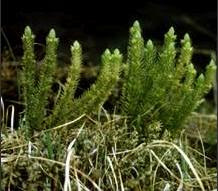 Club Moss, common name for a group of plants closely related to the ferns. Two important genera are low, sometimes creeping evergreen plants that are widely distributed throughout the United States and other temperate and tropical climates. Various tropical species grow on the trunks of trees or on the ground. Usually less than 30 cm (less than 12 in) tall, the plants resemble pine in that their leaves are needlelike. Their widespread use in Christmas wreaths has brought some species close to extinction. In reproduction, spores and asexual cells borne in an elongated cone are scattered on the ground and ripen underground into sexual reproductive organs from which new plants grow.
Club Moss, common name for a group of plants closely related to the ferns. Two important genera are low, sometimes creeping evergreen plants that are widely distributed throughout the United States and other temperate and tropical climates. Various tropical species grow on the trunks of trees or on the ground. Usually less than 30 cm (less than 12 in) tall, the plants resemble pine in that their leaves are needlelike. Their widespread use in Christmas wreaths has brought some species close to extinction. In reproduction, spores and asexual cells borne in an elongated cone are scattered on the ground and ripen underground into sexual reproductive organs from which new plants grow.The common club moss, also called running pine and stag's horn moss, grows in open, dry woods and rocky places. Ground pine or ground cedar has branchlets that resemble the branches of juniper. Tree moss, fir club moss, or foxfeet grows on rocks and in bogs. Fossil species, many of gigantic size, have been found in strata of the Upper Silurian and the Devonian and Carboniferous periods.
Scientific classification: The two important genera of club mosses are Lycopodium, of the family Lycopodiaceae, and Selaginella, of the family Selaginellaceae. The common club moss is classified as Lycopodium clavatum, ground pine or ground cedar as Lycopodium complanatum, and tree moss as Lycopodium selago.



